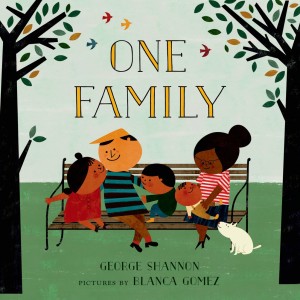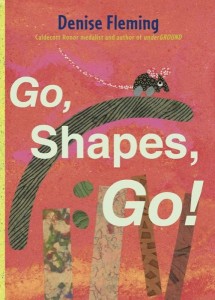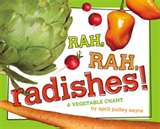“One Family” is one you need for Thanksgiving!
 Thanksgiving is my favorite holiday, but it’s a challenge to find Thanksgiving picture books that connect with kids (I find many “pilgrim and Indian” books that are cringeworthy with stereotypes). This year, I’m focusing on the “thanks” in Thanksgiving and sharing One Family by George Shannon with pictures by Blanca Gomez.
Thanksgiving is my favorite holiday, but it’s a challenge to find Thanksgiving picture books that connect with kids (I find many “pilgrim and Indian” books that are cringeworthy with stereotypes). This year, I’m focusing on the “thanks” in Thanksgiving and sharing One Family by George Shannon with pictures by Blanca Gomez.
The simple counting book is elevated here to show the beauty of what a family can be.
Counting up to ten, we see all kinds of inclusive loving groups: two dads and their daughter (all with different shades of skin), grandparents and kids, a family where the dad and his sons are wearing turbans, a mix of adults and kids where it’s not clear what the relationships are but who cares because they’re smiling and together. On the last page showing all the people we read, “One is one and everyone. One earth. One world. One family.”
Use this book to inspire your students to write and draw about their own families. To continue the counting 1 to 10 structure, students can write about what they are thankful for this holiday. Pair this with the wonderful new nonfiction book Families by Shelly Rotner and Sheila M. Kelly if you want to compare and contrast to hit the Integration of Knowledge & Ideas standard. I count you among my many blessings!
Read More27 Books You Can Use This Year
During the “Moving Beyond the Basics… Reaching for More” conference on Aug. 11 at the Byron Center High School in Michigan, a roomful of teachers and I read through boxes of books. (Thank you, Annemarie Johnson and Kate DiMeo, for inviting me to share informational picture books and to talk about kids’ book publishing.) ((Have I mentioned that my first picture book, GROUNDHOG’S DILEMMA, will come out this December 1 from Charlesbridge?)) After browsing and brainstorming, we generated a list of 27 books with lesson ideas we can use this year in kindergarten through third grade. Feel free to share it!
| Title | Author | Illustrator | Lesson Ideas |
| Alphabeasties and Other Amazing Types | Werner Sharon | Forss, Sarah | alliteration, identifying letters in different fonts – visual learners |
| Aunt Ant Leaves through the Leaves | Coffelt, Nancy | homonyms/homophones | |
| Bee Dance | Chrustowski,Rick | vocabulary, informational reading, chronological text structure, debate if it is “narrative” or “informative” | |
| The Best of Times | Tang, Greg | Briggs, Harry | multiplication in third grade, rules for each and tables |
| Boy, Were We Wrong About the Weather! | Kudlinkski, Kathleen V. | Serra, Sebastia | compare/contrast what we once thought to what we now think, text features, weather in first grade, landforms in second |
| Families | Rotner, Shelley | Rotner, Shelley | “all about” writing at a simple level = great mentor text |
| Greedy Apostrophe: a cautionary tale | Carr, Jan | Long, Ethan | grammar – ways to use an apostrophe |
| Henry’s Map | Elliot, David | mapping skills lesson, pictures with labels = text feature, mentor tex for writing | |
| How To Surprise a Dad | Reagan, Jean | Wildish, Lee | mentor text for “how to” writing that goes beyond basic instruction format, mentor text for incorporating all five senses in details |
| In Mary’s Garden | Kugler, Carson | Kugler, Tina | compare/contrast with “The Most Magnificient Thing” |
| The King Who Rained | Gwynne, Fred | homonyms/homophones/word play, figurative language | |
| Lucky and Stu vs. the Mikanikal Man | Van Wright, Cornelius | reading for pleasure! Friendship themes and good “boy” book | |
| Math Fables | Tang, Greg | Cahoon, Heather | number sense for youngers |
| Me, Too! | Dunklee, Annika | Smith, Lori Joy | opinion writing: “Reason #1”, friendship story to discuss |
| Messy Jesse | Bowles, Paula | writing prompt, “what I’m good at”, punctuation lesson | |
| Nino Wrestles the World | Morales, Yuyi | using context to decode unfamiliar words, appreciation of other languages/cultures | |
| One Boy | Seeger, Laura Vaccaro | finding words within words | |
| One Word from Sophia | Averbeck, Jim | Ismail, Yasmeen | persuasive writing, writing for an audience, text features like glossary |
| Ostriches Are Not Pets! | Niver, Heather Moore | persuasive writing | |
| Over in the Wetlands | Rose, Caroline Starr | Dunlavey, Rob | vocabulary – word choice and author’s craft, context clues, inferring, how do animals prepare for storms compared to how people prepare? |
| Rufus Goes to School | Griswell, Kim T. | Gorbachev, Valeri | use at the beginning of the school year, shows importance of learning how to read, point out persuasive reasons why pigs should (not) go to school |
| Simple Machines | Adler, David A. | Raff, Anna | use as a mentor text for flip books, compare/contrast, nonfiction with illustrations and not photos, text features, easy nonfiction that’s not about animals |
| Speed, Speed, Centipede! | Dahl, Michael | Trover, Zachary | early math counting by tens, shows 10 frames |
| This Plus That: Life’s Little Equations | Rosenthal, Amy Krouse | Corace, Jen | writing with math symbols |
| Water is Water | Paul, Miranda | Chin, Jason | “show, don’t tell”, art tells story as much as text does |
| Wumbers | Rosenthal, Amy Krouse | Lictenheld, Tom | lesson on speech bubbles |
| Zero the Hero | Holub, Joan | Lictenheld, Tom | higher math concepts, friendship, lesson on speech bubbles |
Go, Shapes, Go!
 One of my favorite ways to hook readers during March is Reading Month is to do an author study, and one of my all-time favorite author/illustrators for the elementary crowd is Denise Fleming.
One of my favorite ways to hook readers during March is Reading Month is to do an author study, and one of my all-time favorite author/illustrators for the elementary crowd is Denise Fleming.
I’ve had a book crush on Fleming since 1991 when I first read In the Tall, Tall Grass. The richness of the colors, the text that is so precise and still so simple – it draws in young readers who ask for it over and over. Fleming’s latest book, Go, Shapes, Go! again takes simple but descriptive words and art, and asks kids to play along. It’s brilliant.
A mouse tells recognizable shapes (square, rectangle, triangle, oval, arc) to move to combine into a character. Verbs like bounce, slither, and twirl along with the shapes that are labeled on each page make for the perfect opportunity to build vocabulary while supporting early readers. (Go, Craft & Structure, Go!) The plot of how the shapes combine and recombine to the delight (or dismay) of the mouse makes this book more than just a “name the shape” book.
Denise Fleming’s website is packed with fun stuff for kids to go along with her books. You can print off the shapes she used in Go, Shapes, Go! for kids to move and make their own characters, and there’s a Shapes Match-Up page so kids can match the labeled shape with the word describing how it moved in the book
The process of pulp painting that Fleming uses to make her picture book art is fascinating. Click through denisefleming.com or go to YouTube to see videos of how Fleming colors the cotton rag fiber, makes the stencils, and pours the slurry through a screen. She even has in-depth directions to make paper yourself, and a much easier version using toilet paper – a guaranteed hit for kids!
This March, share Go, Shapes, Go! and compare it with Fleming’s 20+ other wonderful picture books for preschoolers and early elementary students. After you’ve all fallen in love with her work, email Denise through her website. She is an exceptional person as well as an amazing author/illustrator, and your kids will have a whole new appreciation for books after getting to know her.
Read More“Rah, Rah, Radishes” and Go, STEM!
 Happy May, everyone! I had the pleasure of speaking at an early education conference where our theme was literacy and science. I brought stacks of books that tie into STEM (Science, Technology, Engineering, Mathematics) or STEAM (add Art) to share. Rather than just lecture all day, I led a session of “speed-dating” books: we’d spend a few minutes skimming a book and brainstorming ways to use it with students, share our ideas with the group, and pass the book along. This way, we had time to get our hands on over a dozen books and walk away with practical classroom applications. I was so inspired by the fantastic ideas the teachers generated! Here are a few ideas we came up with after reading Rah,Rah, Radishes! A Vegetable Chant by April Pulley Sayre:
Happy May, everyone! I had the pleasure of speaking at an early education conference where our theme was literacy and science. I brought stacks of books that tie into STEM (Science, Technology, Engineering, Mathematics) or STEAM (add Art) to share. Rather than just lecture all day, I led a session of “speed-dating” books: we’d spend a few minutes skimming a book and brainstorming ways to use it with students, share our ideas with the group, and pass the book along. This way, we had time to get our hands on over a dozen books and walk away with practical classroom applications. I was so inspired by the fantastic ideas the teachers generated! Here are a few ideas we came up with after reading Rah,Rah, Radishes! A Vegetable Chant by April Pulley Sayre:
Bring in vegetables found in the book. Sort the vegetables by color and by size.
Classify and sort vegetables by the parts we eat: root vegetables, leaves, etc. Read Tops and Bottoms by Janet Stevens as a tie-in text and talk about which vegetables would be “tops” or “bottoms” according to Hare.
Predict which vegetables will sink or float. Test predictions in a tub of water. Wash the vegetables and talk about textures.
Use the vegetables to make prints.
Compare and contrast with fruits.
Weigh and measure the vegetables. Use a vegetable as a measuring tool.
Take photos of vegetables and label them. Reread the book and have students hold up the corresponding photos.
Make a chart or a Venn diagram with the terms “raw” and “cooked”. Try some vegetables both ways and chart our preferences.
See what other vegetables besides potatoes can be delicious mashed (great for little ones to do the mashing!)
Bring in potatoes with “eyes” sprouting and bring in vegetable seeds. Compare seeds and sprouts, then plant!
Make an edible collage with vegetables.
Practice patterning skills like ABAB, etc. with bite-size veggies and eat when done.
Plan a field trip to a farmer’s market or invite a farmer to come to the classroom for more vegetable experiences.
If you’re interested in the list of science books I shared, please email me at kristenremenar AT gmail DOT com. If you like Rah, Rah, Radishes! A Vegetable Chant, be sure to check out Go, Go, Grapes! A Fruit Chant and Let’s Go Nuts! Seeds We Eat also by April Pulley Sayre. Hooray for early science!
Read More






